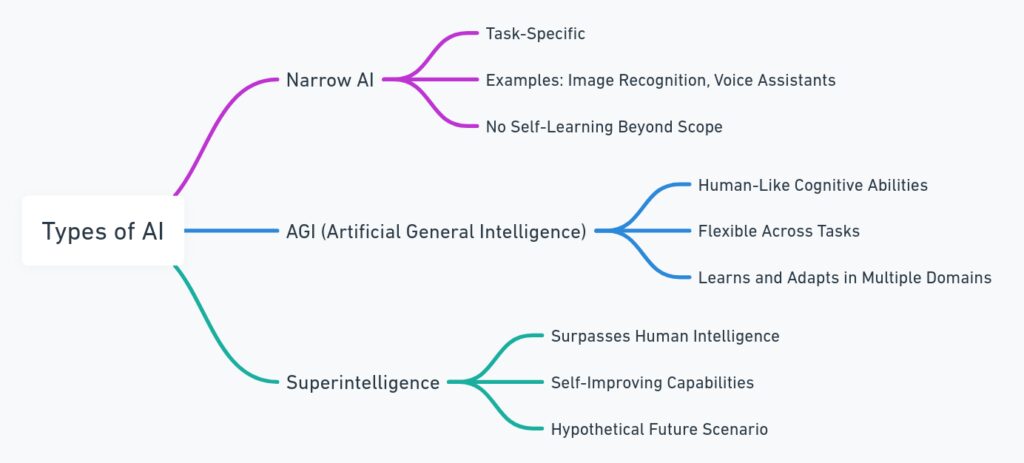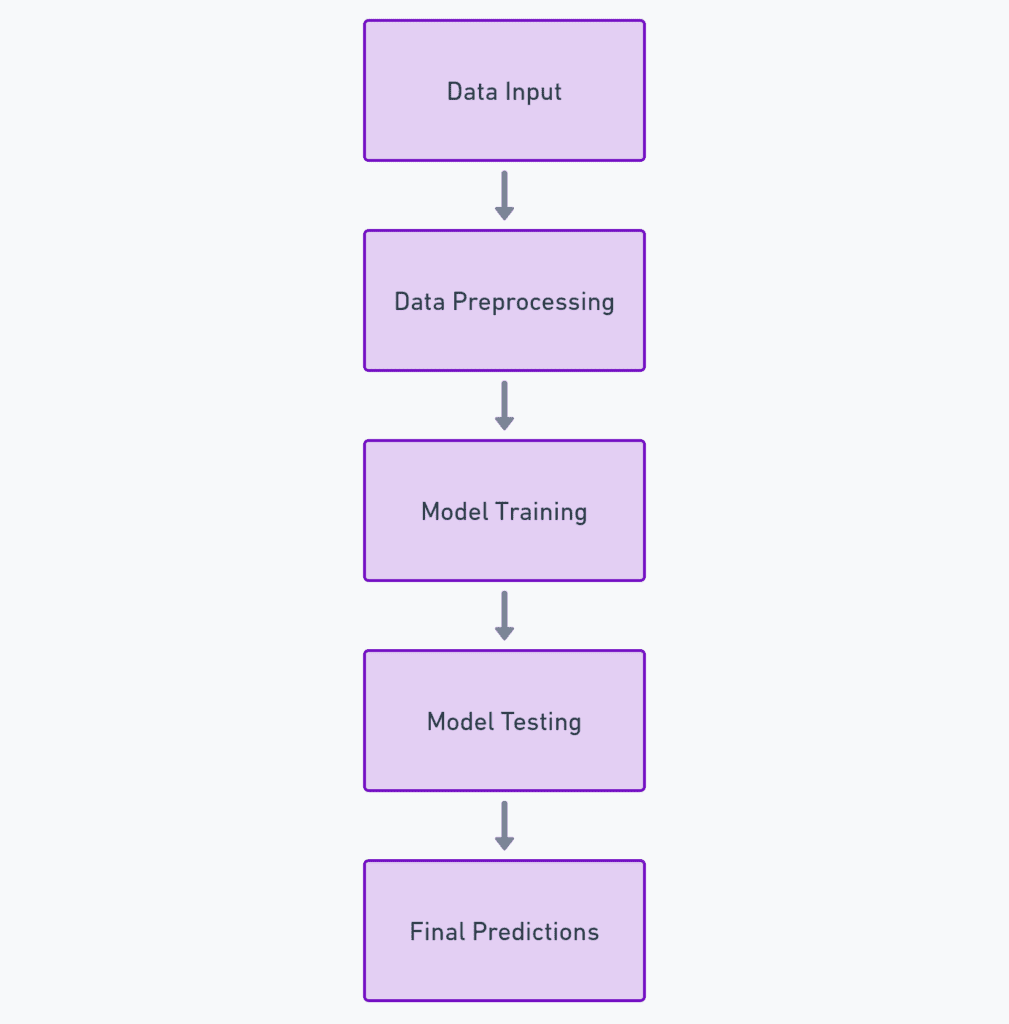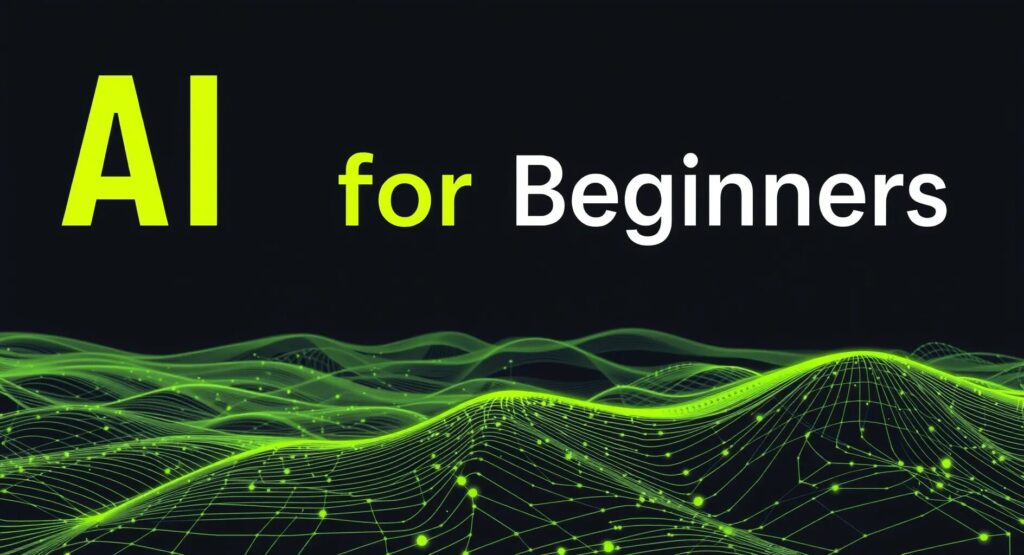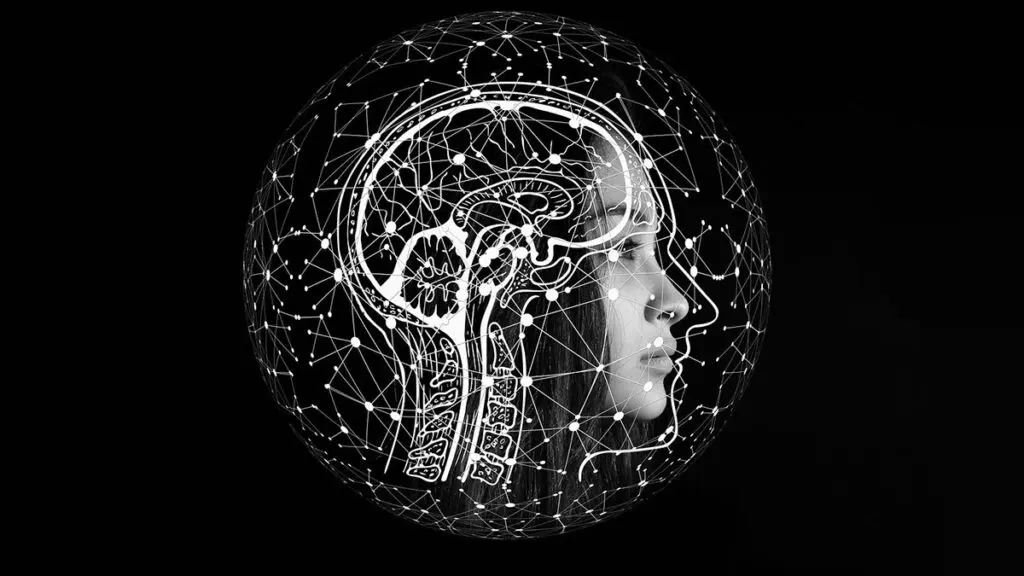
Artificial intelligence is no longer just a futuristic fantasy. It’s an everyday reality reshaping industries, communities, and lives.
If you’ve ever wondered how AI works or why it matters, you’re in the right place. This overview will dive deep into what AI is, how it functions, and its real-world impact.
What Exactly Is Artificial Intelligence?
Artificial intelligence refers to the simulation of human intelligence by machines. The key here is that these machines are programmed to mimic human actions, learn from experiences, and make decisions.
There are different levels of AI, ranging from basic forms like narrow AI, which is designed for specific tasks, to general AI, which can understand, learn, and apply intelligence like a human. We’re still far from achieving true general AI, but narrow AI has already found its place in everyday life.
Think of Siri, self-driving cars, or even your Netflix recommendations. They’re all forms of AI doing specialized jobs and learning from the data they process.
The Evolution of AI: How Did We Get Here?
While the concept of artificial intelligence has been around for decades, AI’s breakthrough into mainstream technology has only occurred in recent years. It all started with simple algorithms and mathematical theories back in the mid-20th century. Scientists like Alan Turing laid the foundation for AI with his Turing Test, which evaluates a machine’s ability to exhibit intelligent behavior.
But it wasn’t until the advent of deep learning and improved computational power in the 2010s that AI truly exploded. Now, with the help of powerful neural networks, AI systems can process vast amounts of data, learning and adapting much faster than before. It’s no wonder AI is evolving at an exponential rate.
How Does AI Learn? The Core Concept of Machine Learning
Machine learning is the driving force behind AI’s ability to “think.” But how does it work? Well, machine learning algorithms analyze data, identify patterns, and make decisions with minimal human intervention. This type of learning enables AI to improve its performance over time.
For instance, if you ask Google Assistant a question, it gets better at understanding your voice and responding appropriately the more you interact with it. The ability to learn from data without being explicitly programmed is what makes AI so powerful and flexible.
Supervised learning, unsupervised learning, and reinforcement learning are the three main types of machine learning techniques. Each serves a unique purpose in teaching AI systems how to interpret data and make predictions.
Types of Artificial Intelligence: From Narrow AI to AGI
Not all AI systems are created equal. There are distinct categories of AI based on their capabilities.
- Narrow AI: This is the most common form of AI we see today. Narrow AI is designed for specific tasks like speech recognition, image analysis, or playing chess. It operates under limited parameters but excels in its designated field.
- General AI (AGI): This refers to systems that possess the ability to perform any intellectual task that a human can. AGI doesn’t exist yet, but it represents the long-term goal of AI development. An AGI would theoretically be able to learn anything, much like a human brain.
- Superintelligence: An even more advanced form of AI, superintelligence would far surpass human cognitive abilities. This idea remains speculative and has raised many ethical concerns in the AI community.

The Role of Deep Learning in AI’s Development
If machine learning is the engine behind AI, deep learning is the turbocharger. Deep learning uses artificial neural networks to model the human brain’s functionality. These networks are structured in layers, each one processing information and passing it on to the next layer for further refinement.
Deep learning is what allows AI to perform complex tasks like natural language processing (NLP), image recognition, and even playing games at a superhuman level, like AlphaGo did when it beat the world champion at Go.
Real-World AI Applications: Where AI Thrives
AI is everywhere. Whether you realize it or not, AI is working behind the scenes in countless industries, transforming how we work and live.
- Healthcare: AI is improving patient diagnosis, treatment recommendations, and even performing surgeries. IBM Watson Health is a prime example of how AI is revolutionizing medicine.
- Finance: AI helps banks detect fraud, automate trading, and provide personalized financial advice. Companies like Robo-Advisors use AI to manage investments with incredible precision.
- Transportation: Self-driving cars are the most talked-about application of AI in transport. Companies like Tesla and Waymo are racing toward perfecting autonomous driving systems that can reduce human error on the road.
- Customer Service: From chatbots to automated email responses, AI is streamlining customer service interactions, making businesses more efficient while improving customer satisfaction.

Ethical Challenges and AI’s Impact on Society
Despite its benefits, AI also brings several ethical dilemmas. One significant concern is the loss of jobs due to automation. With machines capable of performing repetitive tasks faster and more accurately than humans, many fear a future where AI replaces entire industries.
There’s also the issue of data privacy. AI systems rely heavily on data to learn and improve, but this often involves collecting massive amounts of personal information. Striking a balance between innovation and privacy is a growing challenge for AI developers and governments alike.
The possibility of creating biased algorithms is another critical issue. Since AI systems learn from data, if that data contains biases, the AI will replicate them. This can lead to unfair treatment in areas like hiring, law enforcement, and even healthcare.
The Future of AI: What’s Next on the Horizon?
As AI continues to evolve, the line between human intelligence and artificial intelligence will blur. We’re already seeing developments in AI creativity, where machines are generating art, music, and literature. In the coming years, we may witness AI systems that are capable of emotional intelligence and more human-like interactions.
The race toward Artificial General Intelligence is still ongoing, with some experts predicting that AGI could be achieved within the next few decades. If and when that happens, the world will face an entirely new set of challenges—and opportunities.
How Can We Ensure AI Benefits Everyone?
For AI to benefit everyone, we must ensure it is developed responsibly. Governments, organizations, and tech companies need to work together to create regulatory frameworks that keep AI’s power in check. This includes fostering transparency, promoting ethics in AI, and ensuring that AI doesn’t deepen existing societal inequalities.
We also need to invest in AI literacy. The more people understand AI, the more they can take advantage of its benefits while pushing back against any harmful consequences.
AI Wiki – FAQs
What are the different types of AI?
There are several categories of AI:
- Narrow AI, which performs specific tasks (like language translation or image recognition).
- General AI (AGI), which would have the ability to perform any intellectual task a human can (though AGI does not yet exist).
- Superintelligence, a theoretical level of AI that would surpass human intelligence.
What is machine learning, and how is it related to AI?
Machine learning is a subset of AI that focuses on teaching machines to learn from data. Instead of being programmed with explicit instructions, machine learning algorithms analyze data and improve over time, making AI smarter with experience.

What is the difference between AI, machine learning, and deep learning?
- AI is the overall concept of machines mimicking human intelligence.
- Machine learning is a technique within AI that uses algorithms to learn from data.
- Deep learning is a specific type of machine learning that uses artificial neural networks modeled after the human brain to handle more complex tasks, like image recognition and natural language processing.
How is AI used in everyday life?
AI is already integrated into daily life through:
- Smart assistants (like Siri or Google Assistant)
- Recommendation algorithms (on Netflix or Spotify)
- Autonomous vehicles
- Customer service chatbots
- Healthcare diagnostics tools
From improving user experiences to revolutionizing industries, AI is everywhere.
Is AI dangerous?
AI, like any technology, can pose risks if not managed responsibly. Concerns include:
- Job displacement due to automation
- Privacy issues from data collection
- Bias in algorithms that could lead to unfair treatment
However, with proper regulation and ethical development, AI can bring more benefits than harm.
Can AI replace humans?
AI is designed to assist humans, not replace them. While AI can take over repetitive or data-driven tasks, human creativity, empathy, and decision-making remain irreplaceable qualities. Even in fields where AI automates jobs, new opportunities for humans to work alongside AI are likely to emerge.
What are the ethical concerns surrounding AI?
The main ethical concerns include:
- Bias and discrimination in AI decisions
- Privacy issues with data used to train AI systems
- Accountability when AI makes mistakes
- Job loss from automation
Governments and organizations are increasingly focusing on developing ethical frameworks to ensure AI’s impact is positive.
What industries are most affected by AI?
AI is revolutionizing numerous industries, with some seeing more significant transformation than others. The healthcare industry, for example, is leveraging AI to improve diagnostics, create personalized treatment plans, and even perform robotic-assisted surgeries.
In finance, AI helps detect fraud, automate trading, and offer personalized financial advice. Many companies now rely on AI-driven algorithms for decision-making, making processes faster and more efficient.
In manufacturing, AI-powered robots work alongside human employees, improving productivity and reducing errors. Retail uses AI for inventory management, customer service chatbots, and personalized product recommendations.
What is narrow AI, and how is it used?
Narrow AI (also known as weak AI) is designed to perform a specific task or a limited range of tasks. Unlike humans, who can tackle a wide variety of problems, narrow AI excels at specialized functions. It is the most common form of AI today and powers technologies like voice assistants, spam filters, and recommendation systems.
For example, Spotify uses narrow AI to suggest songs based on your past listening habits, while Tesla uses narrow AI in its self-driving technology to navigate roads. Narrow AI can’t generalize knowledge outside its domain, but within its focus area, it often outperforms humans.
What is Artificial General Intelligence (AGI), and does it exist?
Artificial General Intelligence (AGI) refers to a theoretical form of AI that can understand, learn, and apply intelligence across a broad range of tasks, much like a human. Unlike narrow AI, AGI would have the ability to reason, solve complex problems, and adapt to new situations without specific programming.
As of now, AGI does not exist, and scientists and researchers are still debating how close we are to achieving it. The development of AGI would mark a major milestone in AI technology, but it also raises questions about the potential risks and ethical implications.
What are some examples of AI in healthcare?
AI is making waves in healthcare, offering innovations that were once thought impossible. For example, AI-powered systems can analyze medical images with incredible accuracy, helping doctors detect diseases like cancer and heart conditions early on. IBM Watson Health is one of the leading AI platforms in healthcare, assisting physicians in making more informed decisions based on big data.
AI is also used in drug discovery, where algorithms sift through vast amounts of biological data to identify potential treatments. In mental health, AI-driven apps offer personalized therapy sessions, providing emotional support and monitoring for people in real-time. Surgical robots guided by AI are another exciting area, allowing for less invasive procedures with greater precision.
Can AI be creative?
Interestingly, AI is proving that it can create in ways we didn’t think possible. AI-generated art, music, and even writing are becoming more common. AI algorithms like those used in Google’s DeepDream can analyze images and create surreal artwork based on their findings. In music, AI has helped compose songs, with artists like Taryn Southern collaborating with AI to produce entire albums.
While AI’s creativity is still in its early stages and lacks the emotional depth of human art, it demonstrates how far technology can go in expressing itself. As AI systems evolve, we could see more collaborative creativity between humans and machines.
What is the future of AI?
The future of AI promises even more integration into daily life. Experts predict advancements in natural language processing, autonomous systems, and even emotional AI that can interact more human-like. AI could transform industries like healthcare, education, and entertainment. However, it also poses challenges, such as ensuring equitable access to AI technologies and managing its societal impact responsibly.
Resources for Learning More About Artificial Intelligence
If you’re looking to dive deeper into artificial intelligence, here are some great resources to expand your knowledge.
Books on AI:
- Artificial Intelligence: A Guide for Thinking Humans by Melanie Mitchell – A comprehensive introduction to AI, exploring its history, limitations, and future possibilities.
- Superintelligence: Paths, Dangers, Strategies by Nick Bostrom – A fascinating read that explores the long-term impact of AI and the potential rise of superintelligent machines.
- Life 3.0: Being Human in the Age of Artificial Intelligence by Max Tegmark – This book discusses how AI will reshape society, from the economy to our personal lives.
Online Courses:
- Coursera: Machine Learning by Stanford University – Taught by Andrew Ng, this free course is one of the best introductions to machine learning and AI.
- edX: AI for Everyone – Another course by Andrew Ng, designed to teach anyone (regardless of technical background) the fundamentals of AI.
- Udacity: Intro to Artificial Intelligence – A great option for anyone interested in learning AI programming and algorithms.
Websites and Articles:
- MIT Technology Review: AI – Stay up to date with the latest developments and trends in AI through this trusted tech publication.
- OpenAI Blog – Offers insights from one of the leading research organizations in the field of artificial intelligence.
- Towards Data Science – A popular Medium publication offering in-depth articles and tutorials on AI and data science.
Podcasts:
- AI Alignment Podcast – Discussions on AI safety and long-term implications of artificial intelligence.
- The AI Alignment Podcast by The Future of Life Institute – Focuses on the ethical and philosophical questions surrounding AI development.
- Data Skeptic – A fun, accessible podcast that covers AI, machine learning, and related technologies in a way that anyone can understand.





